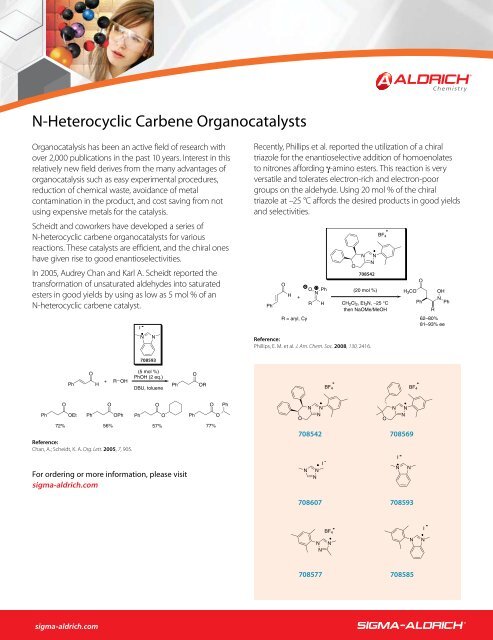Aldrichimica Acta - Sigma-Aldrich
Aldrichimica Acta - Sigma-Aldrich
Aldrichimica Acta - Sigma-Aldrich
You also want an ePaper? Increase the reach of your titles
YUMPU automatically turns print PDFs into web optimized ePapers that Google loves.
n-heterocyclic Carbene Organocatalysts<br />
Organocatalysis has been an active field of research with<br />
over 2,000 publications in the past 10 years. Interest in this<br />
relatively new field derives from the many advantages of<br />
organocatalysis such as easy experimental procedures,<br />
reduction of chemical waste, avoidance of metal<br />
contamination in the product, and cost saving from not<br />
using expensive metals for the catalysis.<br />
Scheidt and coworkers have developed a series of<br />
N-heterocyclic carbene organocatalysts for various<br />
reactions. These catalysts are efficient, and the chiral ones<br />
have given rise to good enantioselectivities.<br />
In 2005, Audrey Chan and Karl A. Scheidt reported the<br />
transformation of unsaturated aldehydes into saturated<br />
esters in good yields by using as low as 5 mol % of an<br />
N-heterocyclic carbene catalyst. Ph<br />
O<br />
Ph OEt<br />
72%<br />
O<br />
Ph H<br />
sigma-aldrich.com<br />
+<br />
R OH<br />
Ph OPh<br />
Reference:<br />
Chan, A.; Scheidt, K. A. Org. Lett. 2005, 7, 905.<br />
O<br />
I<br />
N<br />
N<br />
708593<br />
(5 mol %)<br />
PhOH (2 eq.)<br />
DBU, toluene<br />
O<br />
Ph O<br />
O<br />
Ph OR<br />
Ph O<br />
56% 57% 77%<br />
For ordering or more information, please visit<br />
sigma-aldrich.com<br />
O Ph<br />
Recently, Phillips et al. reported the utilization of a chiral<br />
triazole for the enantioselective addition of homoenolates<br />
to nitrones affording γ-amino esters. This reaction is very<br />
versatile and tolerates electron-rich and electron-poor<br />
groups on the aldehyde. Using 20 mol % of the chiral<br />
triazole at –25 °C affords the desired products in good yields<br />
and selectivities.<br />
O<br />
H<br />
+<br />
O Ph<br />
N<br />
R<br />
H<br />
(20 mol %)<br />
CH2Cl2, Et3N, −25 °C<br />
then NaOMe/MeOH<br />
Reference:<br />
O<br />
O<br />
Phillips, E. H3CO M. et al. J. Am. Chem. OH Soc. 2008, H3CO 130, 2416.<br />
Ph<br />
N<br />
Ph<br />
Ph<br />
70%, 93% ee<br />
O<br />
N<br />
N<br />
N<br />
708542<br />
Ph<br />
BF4<br />
70%, 93% ee<br />
OH<br />
N<br />
Ph<br />
H3CO<br />
H3CO<br />
O<br />
Ph<br />
H3CO<br />
O<br />
R<br />
OH<br />
N<br />
Ph<br />
R = aryl, Cy 62–80%<br />
81–93% ee<br />
O<br />
N<br />
N<br />
N<br />
708542<br />
N<br />
N<br />
N<br />
708607<br />
N<br />
N<br />
708577<br />
I<br />
BF 4<br />
BF 4<br />
N<br />
O<br />
N<br />
N<br />
N<br />
Ph<br />
62%, 90% ee<br />
BF 4<br />
708569<br />
I<br />
N<br />
N<br />
708593<br />
N<br />
708585<br />
I<br />
N<br />
OH<br />
N<br />
Ph

















